Rhododendrons in the Former Soviet Union
Mieczyslaw Czekalski
Department of Ornamental Plants
Agricultural University Poznan, Poland
Translated from Polish by Malgorzata A. Florkowska and Orville M. Lindstrom, Department of Horticulture, University of Georgia Experiment Station, Griffin, GA
Seventeen species of rhododendrons grow in the former Soviet Union according to Schmidt and Alexandrova (39), and over 20 species, according to Poyarkova (37). Interspecific crosses, such as
Rhododendron
x
burjaticum
Malysch. (also known as
R. adamsii
x
parvifolium
) (32, 33),
R.
x
kesselringii
E. Wolf (
R. ponticum
x
R. smirnowii
),
R.
x
nickomontanum
Nak. (
R. aureum
x
R. brachycarpum
) and
R.
x
sochadzeae
Char. et Davlian (
R. caucasicum
x
R. ponticum
) can also be found growing in the Caucasus and other European parts of the former Soviet Union, Siberia, and the Far East. Each area has a different climate, thus the rhododendrons show environmental and genetic differences.
In this article, I will focus on the rhododendrons from the Caucasus area since, in my opinion, they are more ornamentally interesting than other rhododendrons grown in the former Soviet Union. Information used in this article comes from the Russian literature and from personal observations while growing the Caucasian species in Poland and the former Czechoslovakia. I did not include information from English language publications except where comparisons were needed.
The Caucasus is a mountainous region located between the Black and Caspian seas. The main mountain chain, called the Big Caucasus (Bolsoj Kavkaz) conventionally affiliated with Europe, is about 4500 m above sea level (Mt. Elbrus, 5642 m; Mt. Kazbek, 5047 m), 1500 km long, and averages 110 km wide. Approximately 2000 km
2
of glacier can be found at the highest elevations of the mountain chain. Perennial snow borders of the western and eastern mountain chains start at 2700-3000 m, and 3500-3700 m, respectively, above the sea level.
The climate of the Caucasus is diverse. Moderately warm, almost subtropical, to mountainous with cold, long and snowy winters. The mean temperature in January is -7.5°C, and in July/ August about 13.5°C (49). Yearly rainfall in the western part of the mountains is estimated at 2500 mm, and much less in the eastern part (Figure 1).

|
| Figure 1. Distribution of precipitation in the Caucasus area (yearly averages) (Walter 1974). |
Brown-forest soil prevails in the lower elevations of the mountains; in the higher elevations, grassland soil is the most common. Climatic and soil diversity allow growth of diverse plants. In the lower elevations of the Kolchida lowland in the western part of the Mountains (warm, moderate climate) lush-looking, heat-loving plants, including many broadleaf evergreen species, grow.
Situated between the lowland and 600 m is the Kolchida forest. From 600 m to 1100 m,
Castanea sativa
,
Quercus hartwissiana
,
Acer laetum
and other leafy plants are found (Figure 2). In the far western foothills of the mountains, Mediterranean types of vegetation are quite common. While in the eastern foothills of the Caucasus, around the Dagestan area (400-500 m above sea level), woody perennials dominate. On the higher elevations (1000 to 1600 m) of the northern and southern slopes of the Big Caucasus, mixed forests are found.
Fagus orientalis
is a dominant species, especially in the humid areas of this region (35).
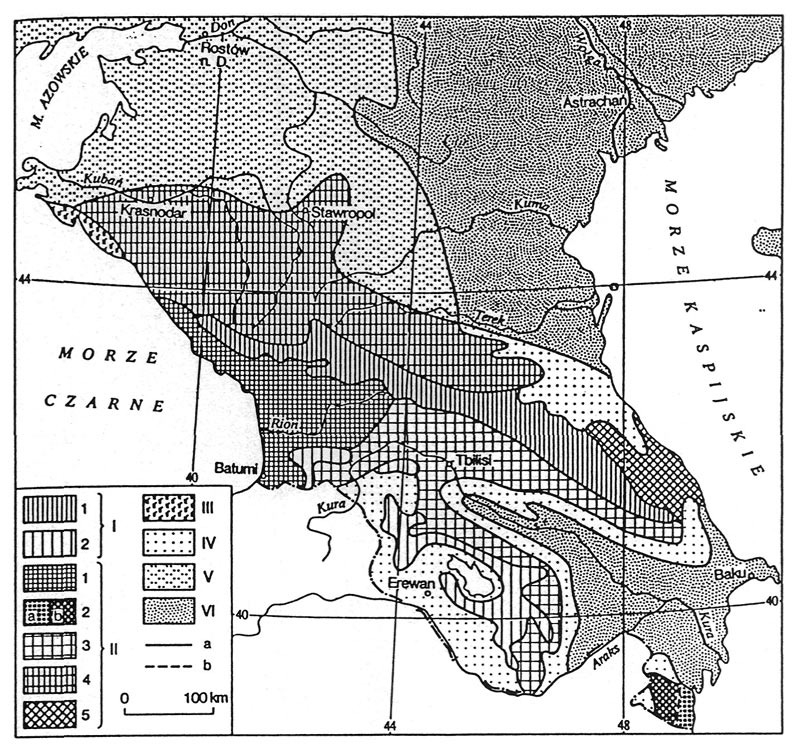
|
|
Figure 2. Plant geography of Caucasus: l-herbs: 1-Caucasus; 2-Lesser Caucasus;
II-montane forests: 1-Kolchida lowland, 2-Hyrkan area (a-Lenkoran lowland, b-Tallish Mountains), 3-eastern Caucasus, 4-northern Caucasus; Ill-succulent type of plants; IV-dry area vegetation (subdesert); V-subdesert and desert vegetation; borders: a-territory, b-provinces (Walter 1974). |
Following are descriptions of five rhododendrons native to the Caucasus area. They include R. caucasicum Pall. R. ponticum L., R. smirnowii Trautv., R. ungernii Trautv., and R. luteum Sweet.
Rhododendron caucasicum
Rhododendron caucasicum
Pall., an evergreen shrub, grows from 0.5 to 1.5 m in height, often with the lower branches spreading to the ground. Leaves are ovate to narrowly-elliptic, from 7 to 10cm long and from 1.5 to 2.5 cm wide. They curl downwards at the edges, and are dark green above, brown and leathery below. Flowers are white or cream colored (rarely light pink) with green spots, and have from 8 to 12 flowers in an inflorescence. Blooms open at the end of May or the beginning of June. The fruit are from 1.5 to 3 cm long, hairy and ripen in October. Seeds are about 1.7 mm long and 0.7 mm wide.
Rhododendron caucasicum
is considered to have little phenotypic variation; however, differences in flower color exist and four of its forms were named. Form
flavidum
Regel. has golden yellow flowers with green spots; f.
rosea-alba
Briot. has white flowers with a pink tint, and blooms earlier than the species; f.
splendens
Briot. has dark pink flowers and also blooms earlier than the species; and f.
stamineum
Hook, has golden yellow flowers with reddish yellow spots (26).
It is possible that
R. caucasicum
is related to the Arctic-Siberian species of
R. aureum
Georgi, since hybrids of both of these species exist (36). Also,
R. caucasicum
has a few characteristics in common with
R. smirnowii
and
R. ungernii
, such as indumentum in the leaves.
In the former republic of Georgia, a description of a natural cross of
R. caucasicum
x
R. ponticum
(
R.
x
sochadzeae
) was found (14).
Rhododendron
x
sochadzeae
grows in the eastern part of the Ochackue Mountain, in the subalpine region (1700 m, or higher), and is also common to Anatolia in Turkey. This cross differs from
R. ponticum
by having white flowers and pubescent ovaries, and from
R. caucasicum
, by having longer, glabrous leaves (43, 13).
Rhododendron caucasicum
grows in the Big and Small Caucasus Mountains (Figure 3), in the subalpine and alpine zones, from 1600 to 3000 m above sea level. It creates wide spreading, single-species thickets on the northern and western slopes, in cool, wet places, where snow melts last, showing some characteristics common to cryophytes. It prefers soils free of limestone; however, sometimes it can be found growing in acid-layered limestone soil, as in Ochačkue Mountain region. On steep slopes, it reduces soil erosion by growing in ravine buttresses, shady areas, and rock crevices. Generally, it prefers shade and avoids southern slopes; however, it can grow well in sunny locations, especially those with high humidity. It has little ecological flexibility, but can survive short periods of drought. The plant does not show invasive characteristics.
The life span of
R. caucasicum
ranges from 50 to 100 years. Although its growth is slow (6 mm yearly shoot growth in young plants), the plant shows vigor producing a large amount of seeds. In some locations it reseeds itself. Plants grown from seed bloom in about 13 years.
Rhododendron caucasicum
was introduced to the gardens of the Caucasus around 1803. That same year the Russian botanist Puszkin donated plants to England's Kew Garden, which were brought to England by the nurseryman C. Loddiges.
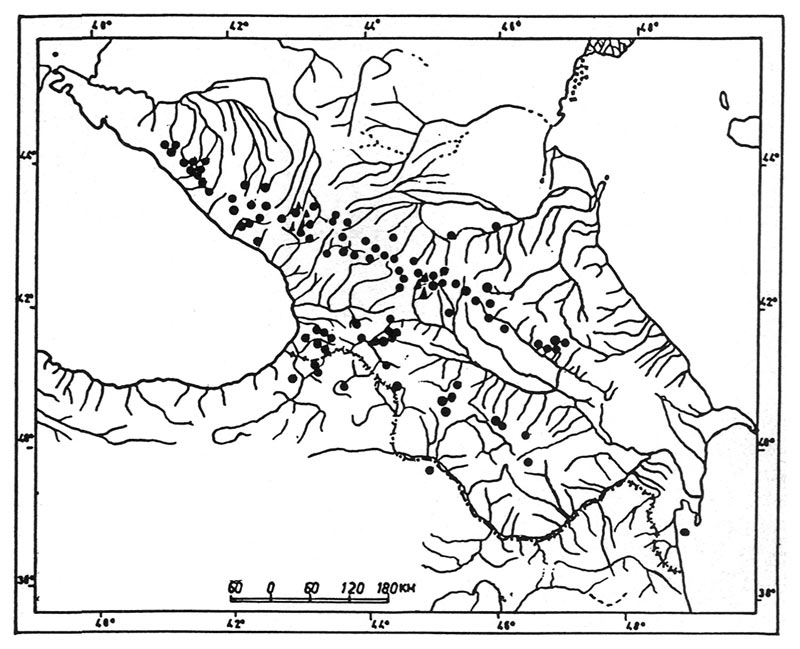
|
| Figure 3. Occurrence of Rhododendron caucasicum (Alexandrova 1978). |
Today R. caucasicum rarely grows in gardens and parks. It has a reputation as a difficult plant to grow. It does not transplant well and grows better when planted in the spring. In the northern and central regions of the former Soviet Union, R. caucasicum needs some winter protection but it is cold hardy in Moscow, St. Petersburg, and the Kirovsk area (Figure 4) where it blooms and produces seeds. The seeds collected in the Riga Botanical Garden averaged 1.53 mm long and 0.46 mm wide, had a weight mass of 1000 seeds equal to 0.078 g, and with 12280 seeds per gram. The germination of these seeds was about 86% (27).
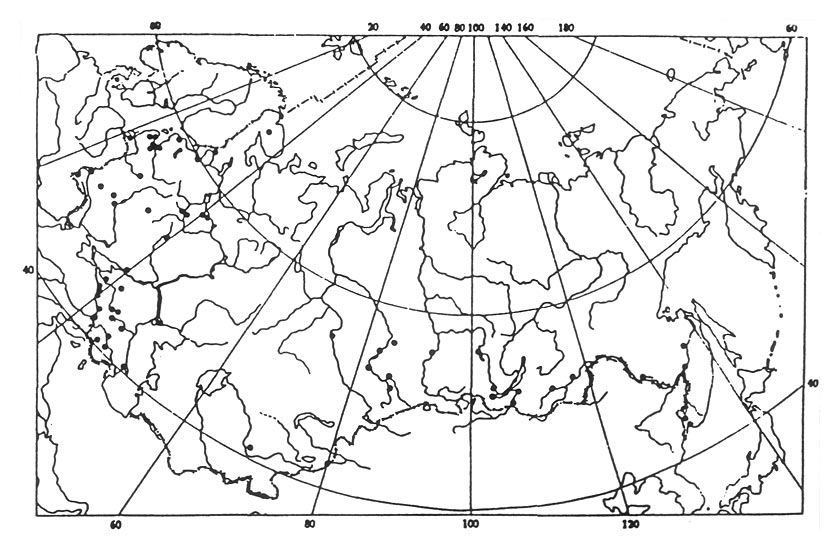
|
|
Figure 4. Areas of introduction of native species of
Rhododendron caucasicum
in the former Soviet Union (Alexandrova 1973). |
In the Central Botanical Garden in Moscow, seedlings that came from Soči (Bulgaria) were planted in 1953. Fifteen-year-old plants reached 0.75 m. Shoots began to grow in mid May and ended, most often, in June. Plants began to bloom when 12 years old. In some years the plants bloom twice in one season; the second bloom time usually continues through October. For the winter season they were protected with leaves and evergreen branches. Without protection they usually were damaged by cold, to various degrees, depending on the severity of the winter weather. After transplanting into a new location, the plants perished (3). Suitable conditions for growing
R. caucasicum
are also found in the foothills of the Ukrainian part of the Carpathian Mountains, in Belarus, and in Central Europe. The plant is not often grown in Poland so its horticulture value here can not be evaluated. In the former Soviet Union,
R. caucasicum
was propagated exclusively from seeds, and information on vegetative propagation was not found in the literature (25).
In the past,
R. caucasicum
was often used in breeding (31, 30). The cultivar 'Jacksonii' is an example of a cross of
R. caucasicum
and Nobleanum Group. It is a dense, low growing, white flowering shrub. The white flowers have a pink shade and light orange spots at the beginning of the growing season.
Rhododendron ponticum
Rhododendron ponticum
L. usually grows from 1 to 6 m in height. In the Kolchida lowlands, plants 8 to 12 m in height and a trunk circumference of 40 cm can be found. Stems are usually arched. Leaves are wide lanceolate, obovate or elliptical, from 9 to 33 cm long, and from 2 to 9 cm wide (3), glabrous on both sides when young, covered with thick cuticles when old. The leaves remain on the plant from two to four years.
Rhododendron ponticum
blooms from the end of April to mid May, and often repeats blooming at the end of the summer. The flowers are from 4 to 6 cm in diameter, violet-purple, light pink, pale violet or white, depending on the specimen, often with yellow or brown spots, and are often fragrant (22). Their fruit ranges from 1 to 3.3 cm long and from 3 to 4 mm wide (13). Seeds are from 1.5 to 1.6 mm long and 0.5 to 0.7 mm wide (3). There are about 10,000 seeds in one gram (48). In Latvia, the average mass of 1000 seeds of white flowered
R. ponticum
, evaluated for several years, was 0.1050 g (28).

|
|
R. ponticum
Photo by Mieczyslaw Czekalski |
The French botanist de Tournefort discovered
R. ponticum
during his trip to the Middle East, in 1700 (10). Alstroemer rediscovered the species in southern Spain 50 years later (23). The growing area of
R. ponticum
consists of three regions: Pyrenees Peninsula, Asia Minor and the Caucasus. The Caucasus and Black Sea region is considered to be its main growing range. In the Caucasus, the rhododendron grows mainly in the Kolchida lowland, the mountainous regions of the Black Sea coastal area, and the western part of the central Caucasus. The northern border of these plants, in the Caucasus range, runs along the Dach river, and the upper parts of Psekupsa, Cice, and Pecki rivers, along the river springs of Bieloy, Kii, Urutena, ache, and in the Alousa on the Central Reservation Park of the Caucasus (3). The southern border of
R. ponticum
growing range is in Turkey, along the river Coroh. The western border runs along the Black Sea coast. The eastern border runs from the headwaters of Kwiryla river and the pass of the Wanuri-Bceg, in southern Osetia (3).
Rhododendron ponticum
does not grow in the eastern Caucasus range due to insufficient rainfall (less than 400 mm a year).
Rhododendron ponticum
grows best at altitudes from 300 to 1500 m; however, in the Caucasus, the plant grows up to elevations of 2200 m above sea level. In the eastern part of the Caucasus, it grows at lower elevations (Figure 5). At 2000 m above sea level it grows as a low shrub, and has smaller leaves compared to the true type (12). In the Batumi area, it grows at sea level and forms a shrub over 7 m in height. The plant grows with
Prunus laurocerasus
(8), in limeless subsoil, and under the canopy of the deciduous forest. In the subalpine region the shrub creates dense thickets. It grows best on the gently, northern and western slopes, of approximately 20°; however, it can tolerate other exposures, as long as moist soil and semi-shade exist (45). In the northern part of its natural growth range
R. ponticum
can be found only in deep and shady ravines (3).
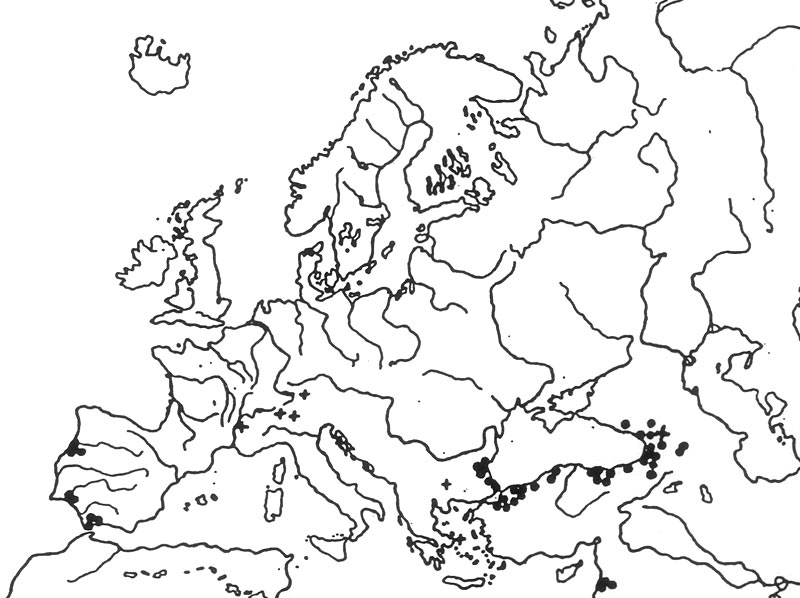
|
|
Figure 5. Occurrence of Rhododendron ponticum: o-present stands,
+-old stands (remains found in various excavations) (Alexandrova 1973). |
The average yearly temperature of
R. ponticum's
natural range is from 12 to 15°C, with a rainfall of 800-1200 mm (45). During the winter, temperatures can drop to -10°C (22). The most favorable growing conditions for the
R. ponticum
are found in Adzaria (Georgia), where the gentle climate has uniform temperature and humidity levels, and calm winds (3). In the Black Sea region, it grows under
Fagetum orientale rhododendrosum
, together with
Prunus laurocerasus
,
Ilex colchica
,
Daphne pontica
,
Ruscus aculeatus
, and
Hedera colchica
. It can be found growing also in alder, carpinus, and chestnut forests, and at higher elevations, with evergreen plants such as
Abies nordmanniana
, Picea orientalis, and
R. luteum
Sweet.
Although
R. ponticum
prefers humid air, moist, acidic, and rich organic soil, it can grow in poorer soil. In the Adzaria forest, shrubs of
R. ponticum
grow inside decaying tree trunks and within the fractured bark of old, but living trees (48). Seeds spread by wind rarely germinate in the thick underbrush; however, seeds often settle and germinate at the forest edge-lines and in open, sunny locations (46).
Rhododendron ponticum
is a polymorphous species. It shows variability in sepals, shade of petals, hairiness of peduncles, and in size and shape of the leaves. Subspecies, varieties and forms are widely described in literature. However, small, morphological differences should not justify introduction of a secondary rank taxon. I agree with M.S. Alexandrova that the species should be treated as indivisible, with high variability in the wild (6).
In the former Soviet Union
R. ponticum
is recommended for planting only under favorable conditions. In the former Baltic Republics
R. ponticum
is cold hardy and bears fruit (3, 27). Around the Black Sea it is used in city plantings of Sochi and Adler (3, 4). In Kiev, it also bears fruit, and in Minsk, it is suggested as the first planting choice, alongside 14 species of other rhododendrons (11). In the northern Caucasus it has a low fruit bearing capacity. In Nalchik and St. Petersburg plants are usually damaged by the cold, and in Tbilisi some watering is required during the summer. The first report on the plant cold hardiness was brought by Kesselring, and dates back to 1909 (3). In the Moscow area
R. ponticum
requires protection from winter and needs watering in the summer (46). A study, conducted in Moscow, showed that white flowering plants brought from high altitudes are the most suitable for growing in the continental parts of the former Soviet Union.
In Poland,
R. ponticum
is often damaged by cold temperatures and can only be grown in the warmest parts of the country. Flower buds are most affected by the cold weather, but their high regenerative capacity allows them to recover from the cold damage over the next growing season (18). In the United States
R. ponticum
survives exposure to temperatures of -20°C. North of Philadelphia, the plant's leaves often experience cold damage (31).
Extracts from
R. ponticum
leaves have reported medicinal value. In the former Soviet Union it is used in the treatment of cardiovascular and digestive system maladies. The leaves contain duretic substances, which can be used in the production of bioflavonoides. They also contain from 8 to 12 percent tanning agents. In the Caucasus area alone,
R. caucasicum
and
R. ponticum
produce about 1.5 million tons of the tanning agent. Unfortunately, leaves also contain some toxic substances. The wood of
R. ponticum
is known for its strength and reddish texture and is often used in woodworking (1).
Rhododendron ponticum
was quite extensively used in the production of hybrids due to their ability to tolerate different climatic conditions, thus increasing the plant's range of growth. However, lower than expected cold resistance, susceptibility to
Phytophthora cinnamomi
and
P. cactorum
, and the domination of pink flowers compared to crosses with other Asian species has hindered the hybridization of
R. ponticum
(31).
Rhododendron ponticum
propagates well from seeds and very well from cuttings (18). The plant shows high anatomical and physiological compatibility with most varieties, especially those from the
R. catawbiense
Hybridum Group. It was used as a rootstock for many rhododendrons grafted in Europe and in the United States, before other methods of propagation were developed. It proved to be a very good rootstock since it bloomed and flowered well in a variety of soil types, with pH ranging from 4.0 to 6.8 (24). However, with low cold resistance and high susceptibility to different pathogens the use of
R. ponticum
as a rootstock has considerably decreased. Observational studies conducted in Poland have shown that even though some plantings of this species experienced various degrees of frost damage during very cold winter seasons, the cold temperatures did not cause the plant to die out. In spite of above ground damage, the root system survived even the most severe winters. Today, thanks to high regeneration rates, 100-year-old specimens of different rhododendron varieties grafted on
R. ponticum's
rootstock can still be found growing in Poland, and in other European countries. The plants of
R. ponticum
grown in Great Britain's mild climate showed good growth and disease resistance even when attempts to destroy the plants, with the strong herbicides, were undertaken.
Rhododendron smirnowii
Rhododendron smirnowii
Trautv. grows as a shrub or small, contorted tree (up to 2 min height). The stems are twisted and raised at the ends. Young stems are densely woolly, becoming glabrous after about two years. The leathery leaves are oblong-elliptical, 7-15 cm long and 3-6 cm wide. Young leaf tops have white tomentum, later become dark green, smooth and shiny. On the bottom, young leaves are covered with a white to greyish indumentum, changing to brown or dark brown when older. Leaf margins curve downwards. The flowers, vegetative buds, and pedicels are also tomentose. Flowers are bell-funnel shaped, from 6 to 8 cm in diameter, light purple-pink to dark pink and red-pink racemes, with 10 to 15 flowers. The petals are wavy and more intensely colored at the edges. Fruit are 2 cm long, usually tomentose, and ripen in late September or early October. Seeds are 1.9 mm long and 0.7 mm wide (2).

|
|
R. smirnowii
Photo by Mieczyslaw Czekalski |
Rhododendron smirnowii
was discovered by M.N. Smirnow and W.A. Massalski in Turkish Lazistan, in 1885. Later, E.R. Trautvetter described and named the plant honoring one of the discoverers (1). However, D.G. Leach (31) claims that Ungern-Sternberg was first to discover the species the same year.
The Southeastern Caucasus was, for a long time, considered the native range for
R. smirnowii
(9, 10, 26, 30, 38, 44). In 1962, a plant expedition from the Batumski Botanical Garden discovered natural stands of the species in Kiedsk (Adzaria area), in the upper flowage of the Merisi river. Natural stands known today are as follows: 1. northern edge of the Adaria-awet Mountain range, in the Namonastrevi area, growing in the
Fagus orientalis
forests, at 1050 to 1600 m above the sea level; 2. the wet canyons of the Gwirabischali and Omastewzia rivers, where it grows along with
Prunus laurocerasus
,
R. ponticum
, and
R. ungernii
; 3. the dry canyons of the Satewzi river, growing on bare rocks at about 1500 m above sea level, along with
R. ungernii
and
Picea orientalis
(Figure 6).
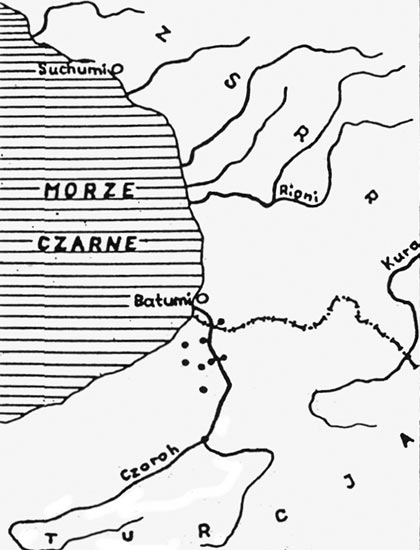
|
|
Figure 6. Stands of
Rhododendron smirnowii
in Turkish Lasistan and in the Caucasus area (Alexandrova 1973). |
In the Caucasus area
R. smirnowii
grows in shady, humid canyons of the forest, in steep ravines, in most light exposures, except for southern exposures. It often grows together with
R. ungernii
and
R. ponticum
, but rarely with
R. caucasicum
and
R. luteum
. The plant prefers rocky areas covered with forests, where it does not have to compete with other rhododendron species. The vertical growth range spreads from 700 to 1600 m above sea level. The fact that this rhododendron can be found growing in dry areas, and on sun warmed rocks, suggests that it has some xeromorphic properties, such as heavy indumentum beneath the leaf. The rhododendron grows on lateritic type soils with the pH ranging from 4.0 to 4.5, and with an annual rainfall of over 2000 mm. The average soil temperature for the coldest months ranges from 5 to 7°C. Temperatures down to -10°C happen rarely and are of short duration (21).
Rhododendron smirnowii
was first introduced for cultivation in Russia in 1886 by W.A. Massalski, who brought it from Karsk to the St. Petersburg Botanical Garden. The Baltic Republic area in the Caucasian part of the Black Sea coastline was found suitable for the introduction of plantings of the species. In St. Petersburg, plants seem to withstand low temperatures quite well and only show some slight cold injury in winters without snow. In Estonia and Latvia,
R. smirnowii
blooms profusely from mid-May to mid-June, and bear fruit. Since 1959, attempts were made to grow the plant in the Moscow area, without much success (5). In Bielorus (Minsk area), where five-year-old seedlings reach a crown width and height of about 20 cm, it has been cultivated since 1966. These plants bloom at the end of May to the beginning of June.
Interesting forms and colors of the flowers, cold resistance and drought tolerance convinced breeders of the value of
R. smirnowii
for selecting new hybrids. The Seidel Brothers in Grngrbschen, Germany, not far from Dresden, used this species for breeding (42). Also, M. Koster, J. Waterer, Magor, Gable and Leach made crosses with the species. In the former Czechoslovakia, B. Kavka and J. Scholz also used the rhododendron in crosses. Kavka named 'Antonin Dwork'* and 'Professor Jelinek'*, and Scholz came up with 'Aurora'*, 'Lajka'*, 'Lunik'*, and 'Sputnik'*. Scholz's (41) desire was to develop a rhododendron that would withstand low temperatures in the winter, and droughts in the summer. He used
R. smirnowii
to achieve his goal. In the Průhonice Arboretum after the cold winter of 1928/29, where the temperature reached -40°C, only this species was not cold damaged. The plants survived extreme weather conditions even after extremely cold winters and dry summers.
Rhododendron smirnowii
has lower cultural requirements, compared to other rhododendrons, and develops a deeper root system. J. Scholz (41) crossed
R. smirnowii
with the named variety 'C.S. Sargent'. The cultivar grows, and blooms profusely, is resistant to cold and drought stress.
In Latvia, the cultivars 'Dace'* and 'Ligava'* show a high level of cold hardiness (27, 28). According to Alexandrova (1) varieties of
R. smirnowii
have interesting leaves but their flowers lack appeal. However, many rhododendron growers do not agree with her opinion. In the 1970s, the well known German company, D. Hobbie in Linnswege, and nurseries from other countries included the species in their breeding programs. It became evident that
R. smirnowii
passed on cold hardiness to its progeny.
In Poland,
R. smirnowii
has not been grown often but has gained popularity in the last few years, and has been included in several breeding programs. There are a few 80-year-old specimens growing in the southwestern part of Poland. Young plants can be found in different parts of the country (15). The plant can withstand temperatures of -35°C, during the extreme winters in Poland.
The botanists from Sukhumi, a Black Sea coast town, claim that
R. smirnowii
is a natural hybrid, developed from the cross of
R. ungernii
and
R. ponticum
(21). However, phenological studies suggest that these parents bloom at different times, which reduces the possibility of cross-pollination. The idea of cross-pollination cannot be entirely dismissed, since the possibility of the plants blooming oddly - at the same time - in the area of growing population exists. M.S. Alexandrova, known for her extensive studies on rhododendrons, did not address the subject.
Rhododendron smirnowii
can be propagated from seeds or vegetatively. Fresh seeds, collected from natural stands in the Caucasus area, had a germination rate from 80 to 85% in the laboratory. Germination occurred 12 to 15 days after sowing. Year-old seedlings were 4.5 cm in height and each plant had about 16 leaves. Blooming first occurred in the sixth year, in the last part of May, before new leaves developed.
Little information exists regarding the vegetative propagation of the species. It was generally considered to be difficult to propagate vegetatively. M. Yltalo in Finland achieved the first promising results in 1979. She used the cuttings from 3 to 4-year-old plants, and treated them with plant growth regulators. This resulted in 44 to 100% rooting (50, 17, 19). The cuttings from older plants rooted less readily. The cultivars can be grafted on the seedlings of the species.
Rhododendron smirnowii
is a reliable rootstock for other evergreen rhododendrons. Also, good anatomical and physiological compatibility is shown with most of the evergreen rhododendron seedlings developed from the cross of
R. smirnowii
and
R. catawbiense
(22).
Rhododendron ungernii
Rhododendron ungernii
Trautv. (Ungern Rhododendron) is a tall shrub or a small (5 to 6 m), contorted tree with branches elevated at the end. Young stems are tomentose, older becoming glabrous. Leaves are obovate, from 12 to 22 cm long, and from 3.5 to 7.5 cm wide, leathery, dark green and glabrous above, covered with white indumentum beneath. Funnel-like flowers are 3.5 cm long, and 5 cm wide, cream colored with a delicate shade of pink or green on the sides of the petals. The inflorescence has from 15 to 20 flowers, and it blooms at the end of May or the beginning of June. The fruit is from 1.2 to 1.5 cm long, covered with reddish tomentum. Seeds are 1.3 mm long and 0.6 mm wide, and ripen in October (1).
Rhododendron ungernii
was discovered by G.N. Kazbek in 1874, in the area of Artwin, Turkey, and described by Trautveter (1). Many believe Ungern-Sternberg discovered the species in 1885 (30, 10, 31). Morphologically the plant is similar to
R. smirnowii
. It is rare in the former Soviet Union, growing only in the southwestern Adzaria area (1). In Turkey, Lazistan is its main growing area. Vertical distribution of the species ranges from 600 m to 1900 m above sea level. The plant is part of the thick underbrush, but can also grow above the timber line. It often grows with
R. smirnowii
in shady, humid forest canyons, and on steep slopes avoiding southern exposure.
Rhododendron ponticum
,
Prunus laurocerasus
,
Ruscus ponticus
can be found growing in the same area along with single specimens of
Picea orientalis
,
Quercus pontica
and
Betula medwedewii
.
In Adzaria (Georgia),
R. ungernii
grows in several geographic areas, various macroclimates, and with various other species. In the upper flowage of the Kinstri River (Chino Mountain), it grows with
Fagus orientalis
. In the upper flowage of the river Dżudżi, it grows at elevations from 1760 to 1900 m above sea level. On the slopes of northwestern to eastern exposures of the Caucasus it grows under the cover of the broad-leaf forest containing
Fagus orientalis
,
Picea orientalis
, and
Abies nordmanniana
. In the fir forest of the Midzybna Mountain, at 1300 to 1600 m above sea level, it grows together with
Fagus orientalis
,
Castanea sativa
, and with
Alnus barbata
. In the Goma Mountain, it is found at the upper level of the
Fagus orientalis
forest. In the upper flowage of the Tbeti river at 1700 m, it is found in the beech/fir forest. It is found on the northeastern slopes of the valley of the river Čakva, 760 m above sea level, among the
R. ponticum
shrubs. It grows in the beech forests of the Batumi area, on the Mtirala Mountain, from 950 to 1100 m above sea level. It is also found on the steep slopes of the river Koronistavi - on the border of the beech forest, 1200 m above sea level. In the upper flow of the Bzubzu river, together with beech forests at altitudes of 1360 m above sea level. In the upper flowage of the Merisi river, it is found on the northern slopes of the beech forests, together with
R. smirnowii
. In the Macacheli River canyon, it is found on the lower border of the beech, and in the chestnut forests at heights from 600 to 700 m above sea level (3).
Rhododendron ungernii
was first introduced for cultivation in Russia, in 1886. W.N. Massalski brought the plant from Karsk to the St. Petersburg Botanical Garden. The fate of these plants is not known. In the former Soviet Union, the species is not often grown. In 1959, it was introduced in the University of Moscow Botanical Garden, and in 1964 was planted in the Botanical Garden of the Soviet Academy of Sciences, also in Moscow. The plants were grown from seeds gathered in the Batumi, and Mtirala Mountain area (Caucasus). In 1975, only two of those shrubs were still living. Seedlings were also brought from Sukhumi, and from the Kew Garden, but they perished during the first year. This rhododendron demands fertile soil, half shade, humid air, and some winter protection (3). It is less cold hardy than
R. smirnowii
.
In 1959, the University Botanical Garden in Riga (Latvia) introduced this rhododendron to their collection. The species is usually damaged in this area during the cold winter season, and it is rarely grown outside Riga (27).
According to T.G. Nitzelius (34),
R. ungernii
is one of the least grown rhododendrons, and it shows high sensitivity to frost. G. Krssmann (30) claims that the rhododendron is cold hardy. In the past, it was thought that this rhododendron is an intermediate species between
R. ponticum
and
R. caucasicum
(39). Often plants grown under the name of
R. ungernii
belong to other species. In the former Soviet Union the natural stands of
R. ungernii
were under absolute protection, and the plant was considered to be a rare, Tertiary relic for Adaria (47).
Rhododendron ungernii
was not extensively propagated. In the former Soviet Union only seed propagation was performed. Seeds germinated 19 to 22 days after sowing. Year-old seedlings grew to as much as 3 cm in height. The author has little information about the use of this rhododendron in breeding; however, it can be of interest to breeders because of the cream colored and later blooming flowers. One should notice that it is quite difficult to obtain reliable breeding material, so assurance that breeding material comes from the natural stands of the species is needed.
Rhododendron luteum
Rhododendron luteum
Sweet is the only deciduous rhododendron species found in the Caucasus. The shrub usually grows from 1.5 to 2 m, but sometimes to 4 m in height, with a 1.5 to 4 m spread. Fruits range from 1.5 to 3 cm long, and are covered with hair. Seeds are yellow, 3.7 mm long and 0.9 mm wide. The seedlings vary in form and flower color. E.L. Wolf, from the Petrograd Botanical Garden, selected five varieties and nine forms. However, today the Wolf's selections are considered not to be different from the species (29, 7).
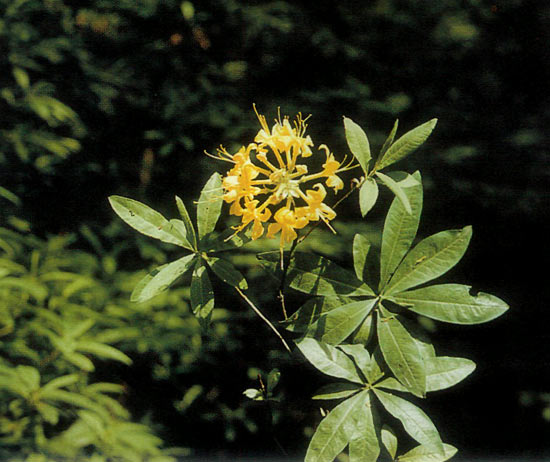
|
|
R. luteum
Photo by Mieczyslaw Czekalski |
Rhododendron luteum grows in three main areas, and in a few isolated stands (7). It grows along the Black Sea coast, from Novorossiysk in the north, to the Big Caucasus, and the eastern Dagestan, in the east. It spreads through the Pontic Mountains and northern Anatolia in Turkey, up to Bosfor and the Aegean Sea, in the west. In the Caucasus, it can be found in the west but is scarce in the east (Figure 7). It is not found in Armenia, Taly Mountains, the Kurinskija or the Lenkoran lowland. The best area for this azalea is the Kolchida lowlands, where fertile soil, and humid air provide the most favorable growing conditions. It can grow on peat but will not tolerate limestone soil. Rhododendron luteum likes full sun but can grow in half-shade. In the shade its stems spread on the ground where they will root, and either their blooms are weak or the plant does not bloom at all.
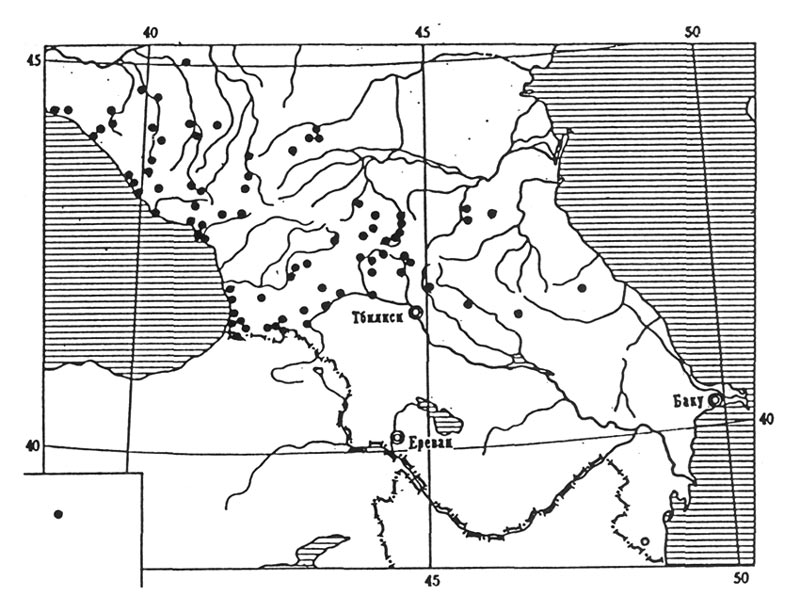
|
| Figure 7. Occurrence of Rhododendron luteum in Caucasus (Alexandrova 1975). |
In the Caucasus,
R. luteum
grows in 12 plant communities (29):
1.
Quercetum-Fagetum rhododendroso-pteridiosum
2.
Querceto rhododendroso-aegopodiosum
3.
Quercetum coryloso-rhododendroso-herbosum
4.
Quercetum-Carpinetum rhododendroso-convallariosum
5.
Querceto-Carpinetum rhododendroso-convallariosum
6.
Querceto-Abieto-Fagetum rhododendroso-herbosum
7.
Querceto-Castaneto-Fagetum rhododendroso-herbosum
8.
Carpi neto-Betulosum-rhododendroso-herbosum
9.
Fagetum rhododendroso-asperuiosum
10.
Carpineto-Quercetum-rhododendroso-graminosum
11.
Querceto-Tremuletum rhododendroso-pterdiosum
12.
Querceto-Carpineto-Aceretum coryloso-rhododendroso-herbosum
The above mentioned plant communities grow on brown or lightly podzolic soil.
Rhododendron luteum
grows in gardens, parks, and landscapes throughout its natural range. In Azerbaijan, it grows well; however, in Bakuriani (Georgia), one-year-old stems are sometimes damaged by the cold. In Taszkient, it blooms but does not bear fruit, and is often damaged by strong sunlight and dry air. In Novosibirsk, Barnaul, and Vladivostock, the plant blooms, but it does not bear fruit, and requires winter protection. In Kareli, it blooms without producing fruit. In St. Petersburg, flower buds and one-year-old stem tips often experience frost damage. In Estonia and Latvia, the azalea is well adapted. In Moscow, it blooms, bears fruit, and produces seeds - with a high germination rate. Since 1965, in Gorki, it blooms profusely and bears an abundance of fruit. In Kijev (Ukraine), plants bloom for the first time after five years of growth, but young plants are damaged, to various degrees, by cold winters. The older plants are more cold hardy. In Lvov, Chernowtsy, Uzhgorod and Vinnitsa (also Ukraine),
R. luteum
bears fruit, and is cold hardy. In Minsk (Bielarus), continuous cultivation of this plant has occurred since 1966. Seven-year-old shrubs, propagated from seeds, have grown to 70 cm in height with a crown spread to 50 cm (11). According to Alexandrova (5),
R. luteum
deserves more attention in Ukraine, non-black soil zones, and in many locations of Siberia and the Far East (5).
Rhododendron luteum
can be easily propagated from seeds, more difficult from cuttings. However, it is possible to propagate the plant from root cuttings (16). Efforts are underway to propagate the plant from hardwood cuttings (20).
Rhododendron luteum
is used extensively in the production of many cultivars grown today all over the world. In Belgium, for example, the Pontic azalea is a parent of the Ghent hybrids that are highly tolerant to the cold.
* unregistered clonal names
References
1. Alexandrova, M.S. O redkich rododendronach Kavkaza. Bulletin Glawnogo Botaniceskogo Sada, 87:36-40; 1973.
2. Alexandrova, M.S. O geografii i ekologii rododendronov prirodnoyflory SSSR. Botaniko-geograficeskiye rayony SSSR. Perspektivy introdukkci rasteniy, pp. 104-113. Izdatelstvo "Nauka", Moskva; 1974.
3. Alexandrova, M.S. Rododen-drony prirodnoy flory SSSR. lzd. "Nauka", Moskva, p. 112; 1975.
4. Alexandrova, M.S. Rododen-drony flory SSSR i perspektivy lch kultury. Bull. Lawn. Bot. Sada 99:3-10; 1976.
5. Alexandrova, M.S. rododendron. lzd. "Lesnaya Promyslennost", Moskva, p. 71; 1989.
6. Anisko, T.; Czekalski, M. Rzanecznik pontyjski -
Rhododendron ponticum
L. Rocznik Dendrologiczny 39:97-110; 1990/1991.
7. Anisko, T.; Czekalski, M. Pontic azalea in Poland. J. Amer. Rhod. Soc. 47, 4:189-191; 1993.
8. Bean, W.J. Trees and shrubs hardy in the British Isles. John Murray, London; 1976.
9. Berg, J.; Krssmann, G. Freiland rhododendron. Verlag E. Ulmer, Stuttgart; 1951.
10. Berg, J; Heft, L. Rhododendron und immergrne Laubgehlze. Verlag E. Ulmer, Stuttgart; 1979.
11. Botianovskiy, I.E. Kultura rododendronov v Belorussyi. lzd. "Nauka it Technika", Minsk, p. 96; 1981.
12. Browicz, K. Chronology of trees and shrubs in South-West Asia and adjacent regions. PWN., Warszawa; 1983.
13. Chamberlain, D.F. A revision of
Rhododendron
. II. Subgenus
Hymenanthes
. Notes from the R.B.G. Edinburgh, 39(2): 209-486; 1982.
14. Charadze, A.L.; Davlianidze, M.F. Kizuceniu introgressivnoy gibridizacyi w rode
Rhododendron
na Kavkaze. [W]; Zametki po sistematike i geografii rasteniy. lzd. Akademii Nauk GSSR, wypusk 27, Tbilisi; 1969.
15. Czekalski, M. Rozanecznik Smirnowa -
Rhododendron smirnowii
Trautv. Monografia dendrologiczno-ogrodnicza. Roczniki Akademii Rolniczej w Poznaniu 156, Ogro-dnictwo 12:3-14; 1985 a.
16. Czekalski, M. Mozliwosci rozmnazania azalii z pedow podziem-nych i korzeni. Ogrodnictwo 7-8:30-31; 1985 b.
17. Czekalski, M.L. Propagation of
Rhododendron maximum
and
Rhododendron smirnowii
by stem cuttings. Acta Horticulturae 226: 573-576; 1988.
18. Czekalski, M. Rozaneczniki. PWRiL., Warszawa, pp. 383; 1991.
19. Czekalski, M; Pokojowczyk, K. Rozmnazanie rozanecznika Smirnowa z sadzonek pedowych. Ogrodnictwo 1:22-25; 1988.
20. Czekalski, M. Czy rozanecznik zolty mozna rozmnazac przez sasdzonki zdrewniale? ERICA - Rocznik Roslin Wrzosowatych 7; 1996 (in press).
21. Dostlkov, A. Begegnung mit den Kaukasischen Rhododendron. Jahrbuch Rhododendron und immrgrne Laubgehlze, p. 43-47, Bremen; 1970.
22. Dostlkov, A. Novegenerativni podnoze pro rododendrony. Casopis Slezskeho Muzea, Serie C (Dendrologie) 26,2:159-172; 1977.
23. Dostlkov, A. Rododendrony. Ceskoslovenska Akademie Vd, Praha, pp. 157; 1981.
24. Hanger, F.E. Propagation of rhododendrons. The Rhododendron Year Book. R.H.S., 4:59-87, London; 1949.
25. Heike, K. Ergebnisse einer Stecklingsvermehrung von Rhododendron. Deutsche Baumschule, 10:376-379; 1979.
26. Kolesnikov, A.I. Dekorativnaya Dendrologia. lzd. "Lesnaya Promy-slennost", Moskva; 1974.
27. Kondratovic, R. Rododendrony. "Avots", Riga; 1981 a.
28. Kondratovic, R. Ja. Rododendrony v Latviyskoy SSR. "Zinatne", Riga; 1981 b.
29. Kozyakov, A.S.; Ivcenko, I.S. K poznaniu genezisa
Rhododendron luteum (Ericaceae)
. Botanicesky Zhurnal 8:1067-1073; 1983.
30. Krssmann, G. Handbuch der Laubgehlze. 2 Bnde. Verlag P. Parey, Berlin und Hamburg; 1960-62.
31. Leach, D.G. Rhododendrons of the World. Ch. Scribner's Sons, New York; 1961.
32. Malyschev, L.I. O nowych i redkich widach s Wostocnogo Sajana. Roslinnost SSSR, Noi. Moskwa-Leningrad, lzd. Akademii Nauk SSSR. 1961.
33. Malyschev, L.I. Wyskogorskaja flora wostocnogo Sajana. Moskva-Leningrad, lzd. "Nauka". 1965.
34. Nitzelius, T.G.
Rhododendron ungernii
Trautv. Jahrbuch Rhododendron und immergrne Laubgehlze, p. 19-27, Bremem; 1974.
35. Podbielkowski, Z. Fitogeografia czesci 'swiata. Europa, Azja, Afryka. PWN. Warszawa; 1995.
36. Poletiko, O.M. Rod Rhododendron. [W]: Derevya i kustarniki SSSR, torn 5. lzd. AN SSSR., Moskva-Leningrad; 1960.
37. Payarkova, A.I. Rod
Rhododendron
. [W]: Flora SSSR, torn 18. lzd. AN SSSR., Moskva - Leningrad; 1952.
38. Rehder, A. Manual of cultivated trees and shrubs. New York; 1949.
39. Schmidt, P., Alexandrova, M.S. Die wildwachsenden Rhododendron-Arten der USSSR. Beitrge zur Gehlzkunde, p. 55-76; 1981.
40. Scholz, J. Ekologie vzdyzelenych rhododendronu. Cas.opis Slezskeho Muzea, Serie c (Dendrologie), 26,2:98-102; 1997.
41. Scholz, J. Slechtni vzdyselnych rododendronu na odolnost vuci mrazu a suchu. Cas. Slezskeho Muzea, Serie C (Dendrologie), 27, 1:37-40; 1978.
42. Seidel, T.J.R. ber Kreutzung, Aklimatisation und Kultur des Rhododendron. Mitteilungen der Deutsche Dendrologische Geselschaft; 1906.
43. Sochadze, E.W; Sochadze, M.E. O rododendronach na izvestnyakovom massive Ochackuye (Abchazya). Botanicesky Zhurnal, 45, 4; 1960.
44. Stevenson, J.B. (red) The species of
Rhododendron
. The Rhododendron Society, London; 1930.
45. Satalina, M.S. Ekologo-morfologiceskiye ososbennosti neko-torych vidov kavkazkich rododendronov. International Symposium on Biology of Woody Plants. Publishing House of Slovak Akademy of Sciences, p. 537-542, Bratislava; 1973.
46. Satalina, M.S. Pontiyskiy Rododendron. Priroda, 11:78; 1963.
47. Takhtayan, A.L. "Krasnaya Kniga" - diko rastusciye widy flory SSSR podlegayusciye ochrane. lzd. AN SSSR, Leningrad; 1975.
48. Tatisvili, G.S. Rododendron potiyskiy. Cvetovodstvo 11:11-12; 1962.
49. Walter, H. Die Vegetation Osteuropas, Nord-und Zentralasiens. Verl. G. Fischer, Stuttgart; 1974.
50. Yltalo, M. Alpiruusun pistokaiden juurtumisenn vaikuttavia tekijit. Journal of the Scientific Agricultural Society of Finland, 51, 3:163-171; 1979.